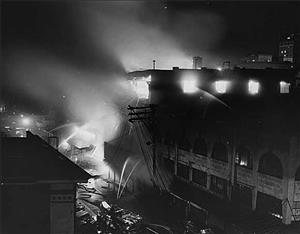On December 14, 1941, a three-alarm fire strikes the Sanitary Public Market building at Pike Place Market in Seattle, causing major damage. The fire's mysterious origin and rapid spread and that it occurs only seven days after Japan's attack on Pearl Harbor leads many to speculate that the fire is the work of Japanese saboteurs. However, the cause of the fire is never determined.
Big Trouble
Darkness was falling just before 5 p.m. on Sunday afternoon, December 14, 1941, when the first sign of trouble suddenly appeared. Courtney Payton, night watchman for the Sanitary Market (which covered much of the block between Pike and Pine streets and 1st Avenue and Pike Place) was in his apartment in the building when he heard four muffled explosions. Looking out, he saw flames erupt from the building's west (Pike Place) side.
The Seattle Star reported the next day that the fire began on the third floor of the building, but it had spread to all four of the building's floors by the time the first firefighters arrived. More help was summoned, and within an hour there were 150 firefighters from 17 engine companies and four truck companies fighting the blaze. They were aided by several hundred volunteer auxiliary firefighters as well as other volunteers, including soldiers and sailors.
Another 200 men from the Home Defense Infantry Regiment joined 60 police officers to control the thousands of onlookers (some fearing the fire was the result of an air raid) who converged on the scene. The crowd became so large that Seattle Police Chief Herbert Kimsey banned vehicle traffic from 1st, 2nd, and 3rd avenues in the vicinity of Pike and Pine. Spectators were also cleared up to a block away from the building.
A Furious Fire
Burning embers blew from the building and landed on nearby structures, but firefighters doused the sparks before they caused any damage. But there were about 500 people inside the Liberty Theatre, directly across 1st Avenue from the Market, who were not aware of the fire. Fearing it might spread, Seattle Fire Chief William Fitzgerald walked into the theater and quietly told the crowd to evacuate. The patrons calmly obliged, though the theater's mascot, a white cat named Lightning, was less obliging. The frightened feline briefly ran amok, then hid until he was rescued by a theater usher.
Smoke poured into the street as the firefighters fought the blaze, briefly reducing visibility to near zero on 1st Avenue. Meanwhile, power lines near the Sanitary Market burned and fell to the street in showers of sparks. The fire's heat was so intense in the building's basement that it caused glass insets in the 1st Avenue sidewalk above to pop out. Cars parked nearby became so hot that steam shot from them when water from fire hoses struck the vehicles. Police-operated tow trucks soon arrived and hauled the cars away, in some cases having to break into them to release their brakes.
For two hours the fire burned furiously, but firefighters eventually gained the upper hand. By 8 p.m. the worst was over. Several hours later, high winds blew into Seattle, causing more than one firefighter to observe how fortunate it was that the storm hadn't arrived earlier.
Sabotage -- or Accident?
The building was damaged extensively, as was the property of its tenants inside. Damage was estimated at a minimum of $100,000 ($1.5 million in 2011 dollars). Seattleites, still reeling from the news of Japan's attack on Pearl Harbor the preceding Sunday, wondered if the fire was the work of Japanese saboteurs. But this was never proven, and the building was susceptible to an accident -- it was filled with flammable items such as gunny sacks, cooking oils and fats, and even crates of matches. A Seattle P-I reporter wrote that "crates of matches, as they ignited, created minor explosions and flares of light" ("Three-Alarm Blaze Rages Downtown").
Seven minor injuries were reported as a result of the fire. (A fire battalion chief also suffered a heart attack after returning to his home from fighting the blaze, but was reported to be in satisfactory condition the next day.) The FBI joined with local fire investigators to try to establish the cause of the fire, but it was never determined.

